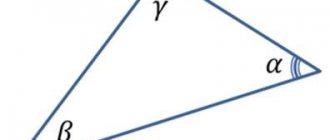Memo for elementary school students “How to work on a task”
This memo is intended for primary school students when working on problems in mathematics lessons and when doing homework. It will help students better navigate the text of the problem, build a plan for solving the problem, and choose the right solution. With its help, the student learns to think about completing a task in a certain order. This skill will be needed in middle grades, when the tasks become more complex.
Memo “How to solve problems”
1. Read the problem and imagine what it says.
2. Highlight the condition and question. 3. Write down the condition briefly or complete the drawing (make a short note). 4. Think about whether it is possible to immediately answer the question of the task. If not, why not? What do you need to know first, what then? 5. Make a solution plan. 6. Execute the solution. 7. Check the solution and write down the answer to the problem. An approximate plan for answering and reasoning when solving a problem: Analysis of the problem.
1. It is known that ... (tell the condition of the problem) 2. We need to find out ... (repeat the question) 3. To answer the question of the problem, we must ... 4. We cannot immediately answer the question of the problem, since we do not know ... 5. Therefore, in In the first action we will find out... 6. In the second action we will answer the question of the problem.
To do this... (what action are we performing) 7. Answer... Making a short record of problems
One of the difficult issues in studying mathematics is solving problems.
Children experience great difficulty in analyzing a problem, and this is where the key to solving it lies. This is greatly facilitated by compiling a short note in such a form that a model of the life situation described in the problem appears. This model will allow us to simplify, discard the unimportant and reveal the relationship between quantities. The purpose
of writing a short note is to highlight the quantities included in the problem and correctly establish the dependencies between them.
When compiling a short note for a problem, you should be guided by the following provisions:
1. A short note is performed after familiarization with the content of the problem and serves as an important means of finding solutions. Based on it, students analyze the problem; 2. A brief entry should be concise, clear and clearly reflect the relationships between quantities. It can be made in various forms: in the form of a table, drawing, picture, diagram, etc.
We recommend watching:
Spelling dictation in 4th grade Integrated test work for 3rd grade Didactic materials on the Russian language for elementary school. Letter of an unpronounceable consonant in ko Test on the topic: Life of the ancient Slavs, grade 4 The world around us
Similar articles:
Mathematics test on the topic “Numbering numbers greater than a thousand” in 4th grade
How to teach solving math problems to a child in grades 1-4
Since acquaintance with mathematics begins in elementary school, the acquisition of the skill to cope with such puzzles occurs during this period.
What is the skill needed for?
It is important to understand that having learned to cope with mathematical tasks in elementary school, a child will be able to successfully master chemistry, physics, astronomy and other subjects in high school. Parents are simply obliged to help their child with mathematics in the first grades, since this type of activity is directly related to clear logical thinking, the ability to analyze, and draw conclusions.
Good to know!
In addition, counting tasks train memory, attention, develop the ability to reason, and have a positive effect on cognitive abilities in general.
General learning algorithm
The following sequence of steps should be followed to teach children to correctly perform mathematical tasks:
- Carefully read the conditions and decompose tasks into stages: condition, question, solution, answer.
- Making a plan to find out the unknown. For little ones, it is good to use drawings - diagrams at this stage, give examples from personal experience that are similar to the conditions of the task, for better perception.
It is also appropriate to use simple scenarios that allow children to “be inside the task.” - Focus on the puzzle text and search for the answer in it. It is important to teach that in mathematics there are no unnecessary phrases, they are all important and are used to find the answer that is embedded in the formulation of sentences.
- Practice and practice again. In order for children to successfully master the skills of addition, subtraction, and multiplication, they need to bring these actions to automaticity.
Common mistakes in problem solving
The main mistakes in the process of searching for an answer are the following:
- a quick reading of the conditions of the problem, which does not allow you to determine which answer is needed;
- misunderstanding of the sequence of actions, especially when searching for several unknowns;
- an incorrect answer may be formal, when the units of measurement are mixed up, or incorrectly calculated.
Remember!
It is important to teach your child to correct and find mistakes on his own, to double-check a task, and not just put it aside if something doesn’t work out.
See also:
How to teach a child to play chess from scratch at home



